CONFLICT AND INSECURITY
Conflict/insecurity was the most significant driver in 19 countries where 117 million people were in IPC/CH Phase 3 or above or equivalent.
What is the Global Report on Food Crises?
The GRFC 2023 is the result of a collaborative effort among 16 partners to achieve a joint consensus-based assessment of acute food insecurity in countries with food crises. The report aims to inform humanitarian and development action by providing the global and national food security community with independent and consensus-based evidence and analysis.
Published by the Food Security Information Network (FSIN) in support of the Global Network against Food Crises (GNAFC), the GRFC is the reference document on global, regional and country-level acute food insecurity in 2022. It provides analysis of the key drivers of acute food insecurity in food-crisis contexts and presents an overview of food-crisis trends since 2016.
Methodology
The main sources of acute food insecurity are the Integrated Food Security Phase Classification (IPC) and the Cadre Harmonisé (CH).
For countries/territories for which an IPC/CH analysis is not available, estimates are derived from IPC-compatible sources like FEWS NET or from WFP Consolidated Approach for Reporting on indicators (CARI) and Humanitarian Needs Overviews (HNO) and Humanitarian Response Plans (HRP), published by OCHA.
Households are able to meet essential food and non-food needs without engaging in atypical and unsustainable strategies to access food and income
Households have minimally adequate food consumption but are unable to afford some essential non-food expenditures without engaging in stress-coping strategies
Households have food consumption gaps with high or above usual acute malnutrition OR accelerated depletion of livelihoods assets OR resort to crisis coping strategies
Households have large food consumption gaps resulting in very high acute malnutrition and excess mortality OR face extreme loss of livelihood assets OR resort to emergency coping strategies
Households have an extreme lack of food and/or other basic needs. Starvation, death, destitution and extremely critical acute malnutrition levels are evident
Action for disaster risk reduction and livelihoods protection
Urgent action required
“"Food crisis occurs when rates of acute food insecurity and malnutrition rise sharply at local or national levels, raising the need for emergency food assistance. A food crisis is usually set off by a shock or combination of shocks that affect one or more of the pillars of food security: food availability, food access, food utilization or food stability".”.
Out of the 58 food crises countries included in the GRFC, 42 were identified as major food crises because they had more than 1 million people or 20 percent of the population in IPC Phase 3 or above or equivalent.
The ten countries/territories with the highest numbers of people in IPC/CH Phase 3 or above or equivalent in 2022 and the share of analysed population in these phases
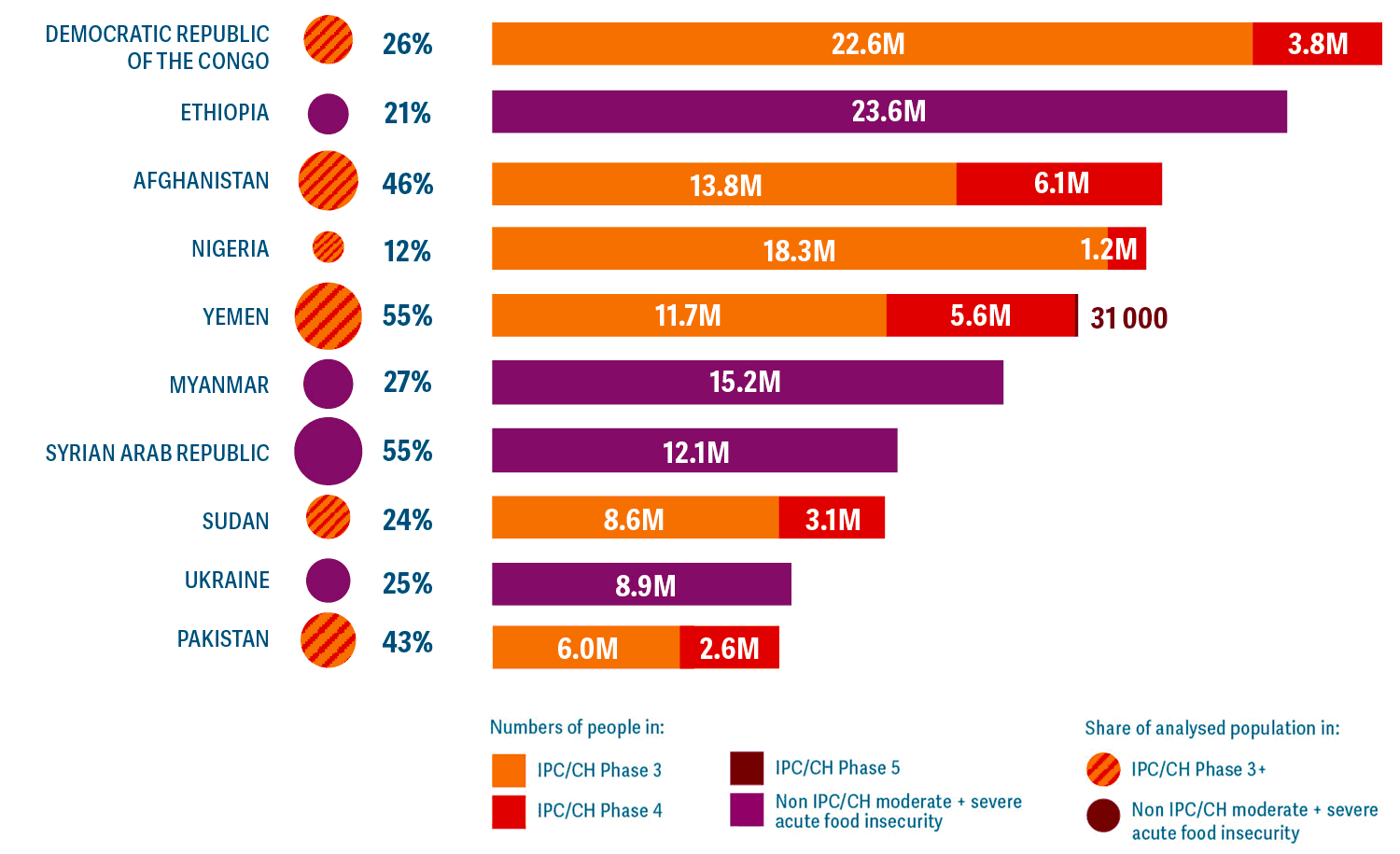
The food crises with the highest severity (at least 30% of the analysed population in IPC/CH Phase 3 or above or equivalent)
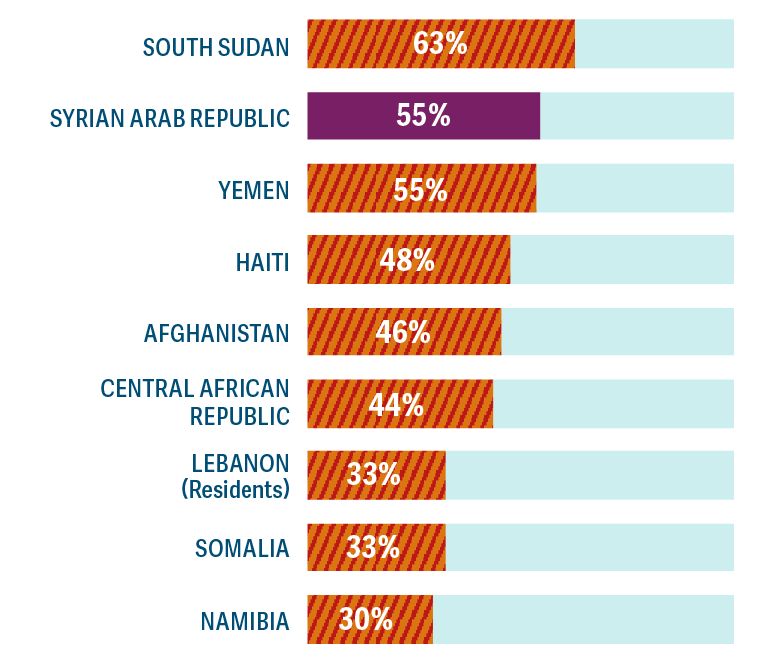
Other food crises with a high localized severity (at least 35% of the analysed population in IPC/CH Phase 3 or above or equivalent)

Catastrophe (IPC/CH Phase 5)
People in seven countries faced Catastrophe (IPC/CH Phase 5) at some point during 2022. More than half of the people facing these conditions were in Somalia (57 percent), but these extreme circumstances also affected populations in South Sudan, Yemen, Afghanistan, Haiti (for the first time in the history of the GRFC), Nigeria and Burkina Faso.
What does it mean to live in IPC/CH Phase 5?
Households have an extreme lack of food and/or other basic needs even after full employment of coping strategies. Starvation, death, destitution and extremely critical acute malnutrition levels are evident.
*This is not the same analysis as the one showing the acute food insecurity peak in 2022. Source: IPC TWGs, 2022.
2021
2022
2021
2022
Conflict and insecurity, economic shocks and weather extremes are the main drivers of acute food insecurity. They are interrelated and mutually reinforcing and continue to erode livelihoods and destroy lives in a vicious cycle. Increasingly these drivers are acting at the global scale, with climate change and successive economic shocks – particularly linked to the socioeconomic effects of the COVID-19 pandemic and war in Ukraine.
In 2022, economic shocks surpassed conflict as the main driver of acute food insecurity in terms of number of countries/territories affected, with conflict remaining the main driver for a higher number of people.
Number of people in ipc/ch phase 3 or above or equivalent by primary driver, 2018 - 2022
Note: Economic shocks include the indirect impact of COVID-19 in 2020 and 2021 and the effects of the war in Ukraine in 2022. Source: FSIN, GRFC 2019–2023.
CONFLICT AND INSECURITY
Conflict/insecurity was the most significant driver in 19 countries where 117 million people were in IPC/CH Phase 3 or above or equivalent.
ECONOMIC SHOCKS
Economic shocks (including the socioeconomic impacts of COVID-19 and the repercussions of the war in Ukraine) became the main driver in 27 countries with 83.9 million people in IPC/CH Phase 3 or above or equivalent – up from 30.2 million people in 21 countries in 2021.
WEATHER EXTREMES
Weather extremes were the primary driver of acute food insecurity in 12 countries where 56.8 million people were in IPC/CH Phase 3 or above or equivalent, more than double the number of people (23.5 million) in eight countries in 2021.
The war in Ukraine disrupted agricultural production and trade in the Black Sea region, contributing to high international food prices in the first half of 2022. While measuring the precise impact of the war on global food security is difficult, the conflict continues to affect food security indirectly, particularly in the large part of GRFC countries/territories, which are food import-dependent low-income countries whose fragile economic resilience had already been battered by the COVID-19 pandemic.
By the end of 2022, food prices had increased in all GRFC countries/territories, with food inflation being over 10 percent in 38 out of 58 countries/territories with food crises. Nearly all of the countries whose currencies lost value at an abnormally fast rate in 2022 were GRFC countries/ territories.
Percentage increase in the price of staple foods December 2021–December 2022 in GRFC qualifying countries/territories
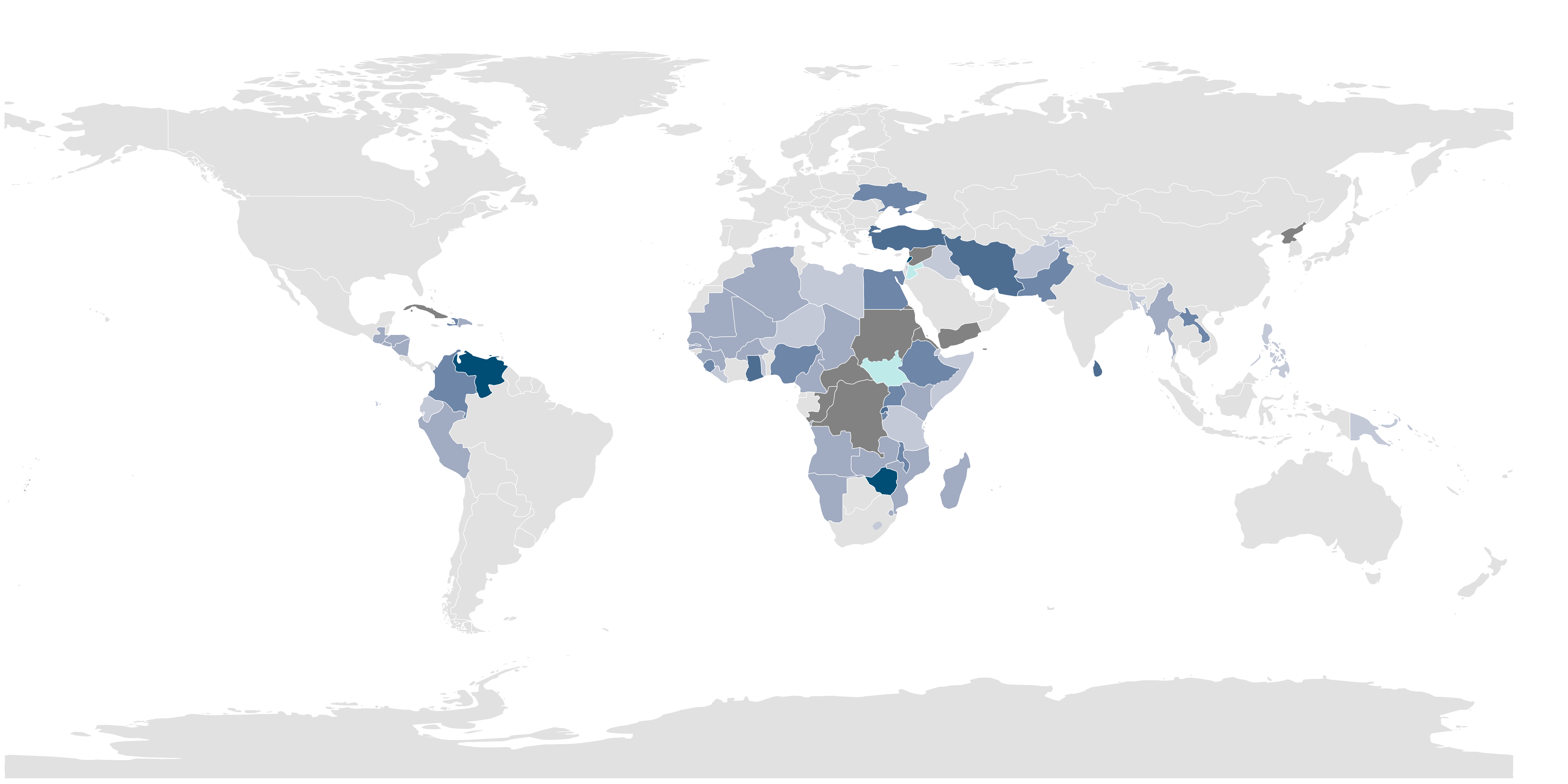
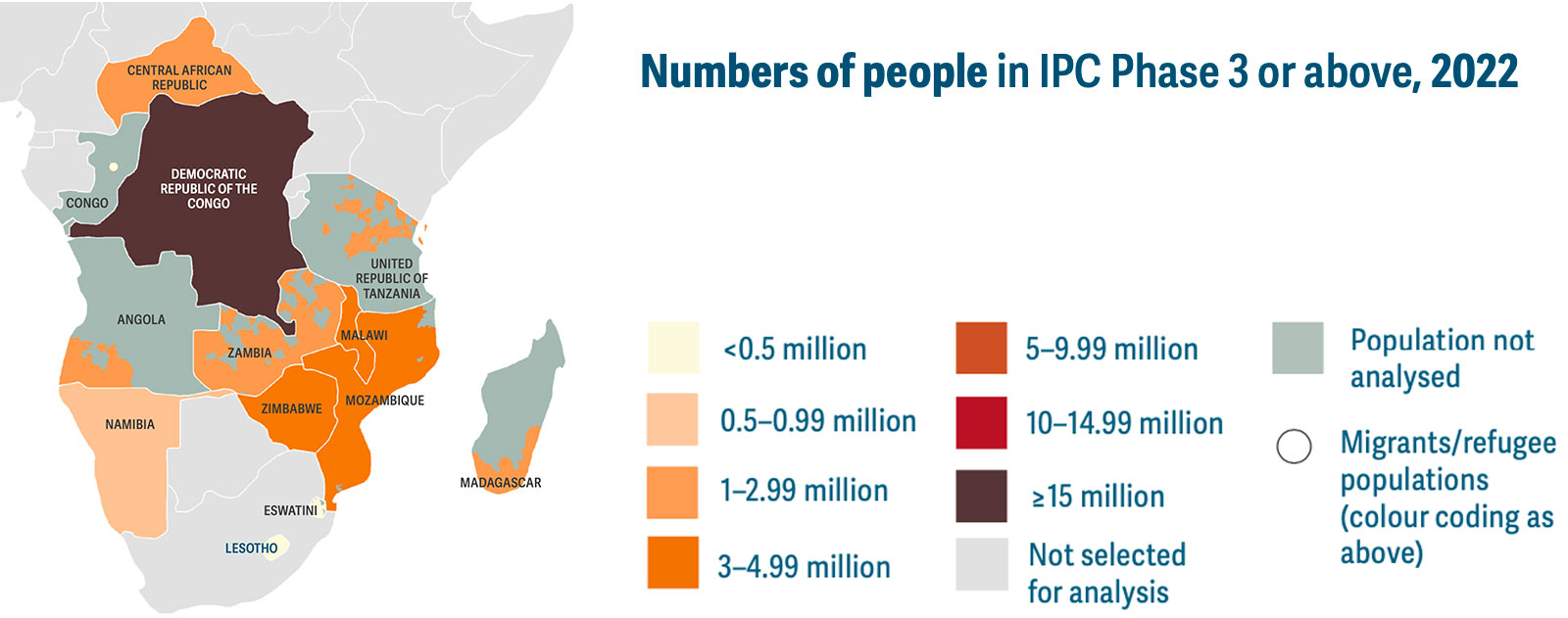
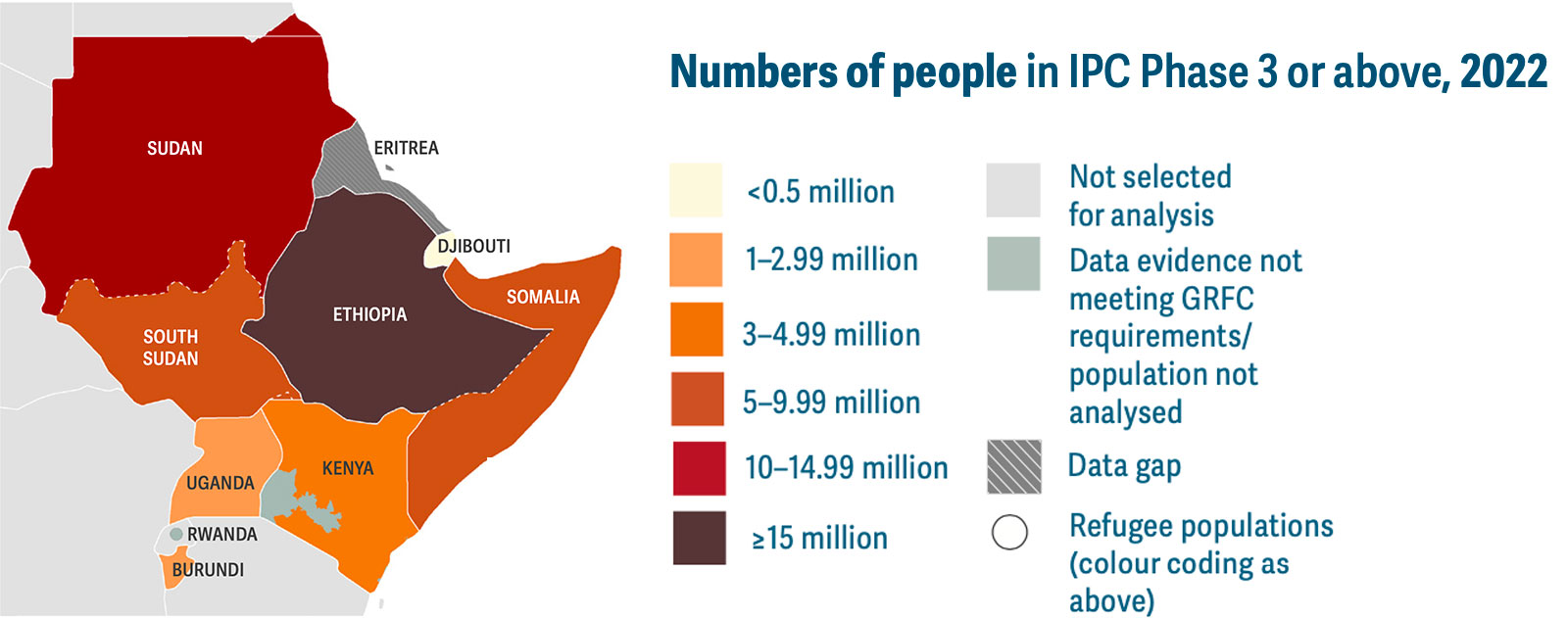
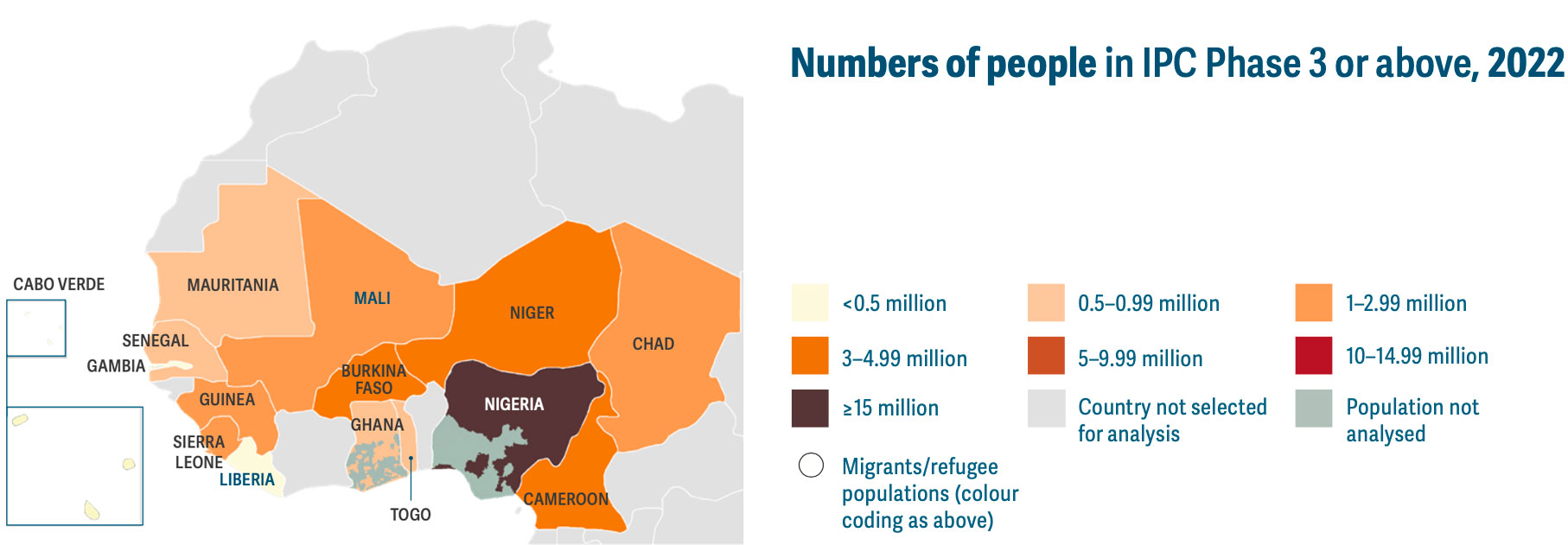
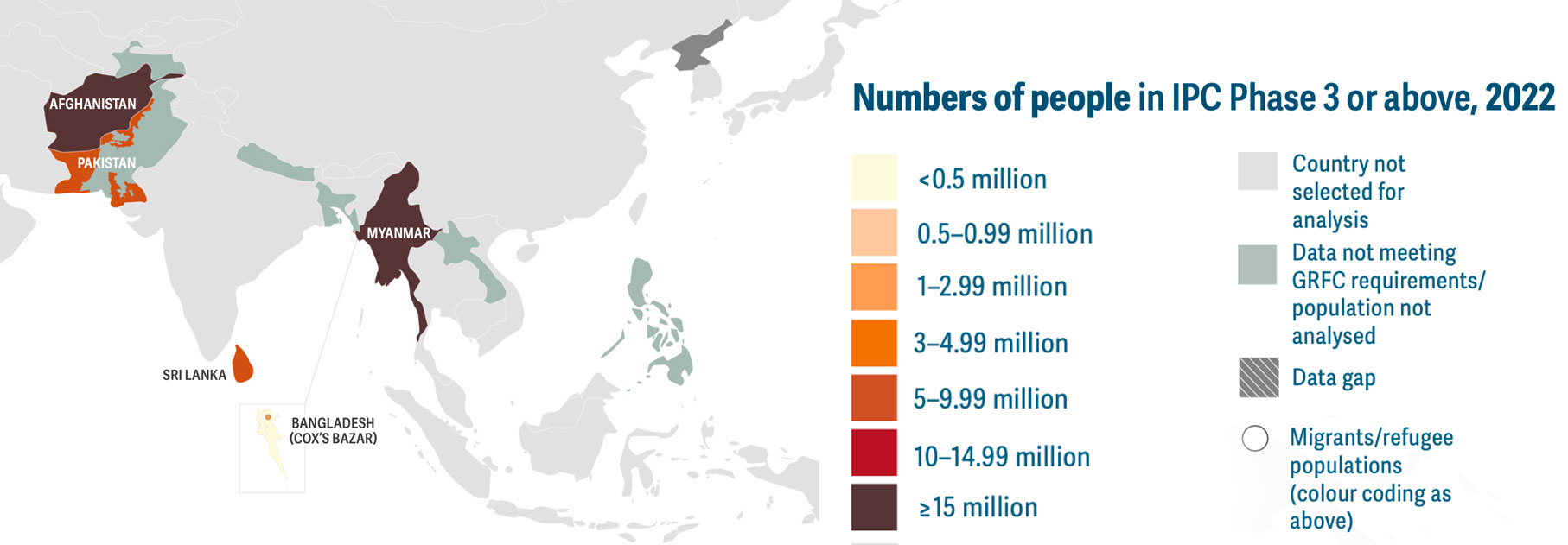
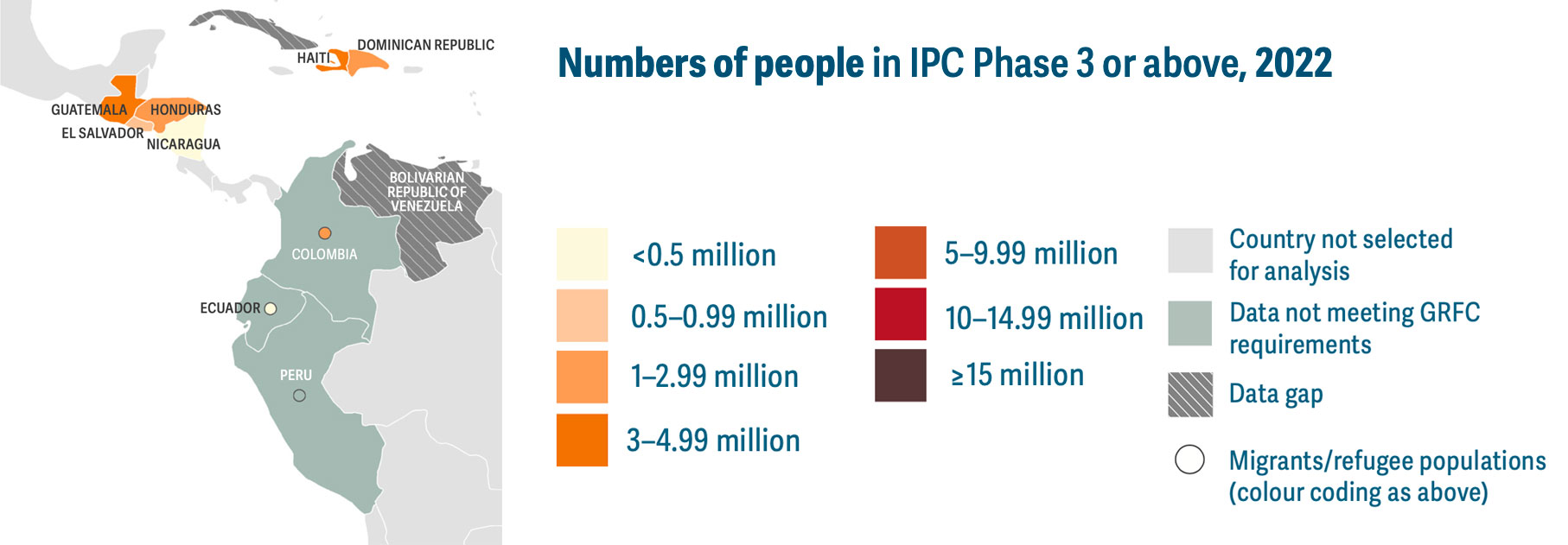
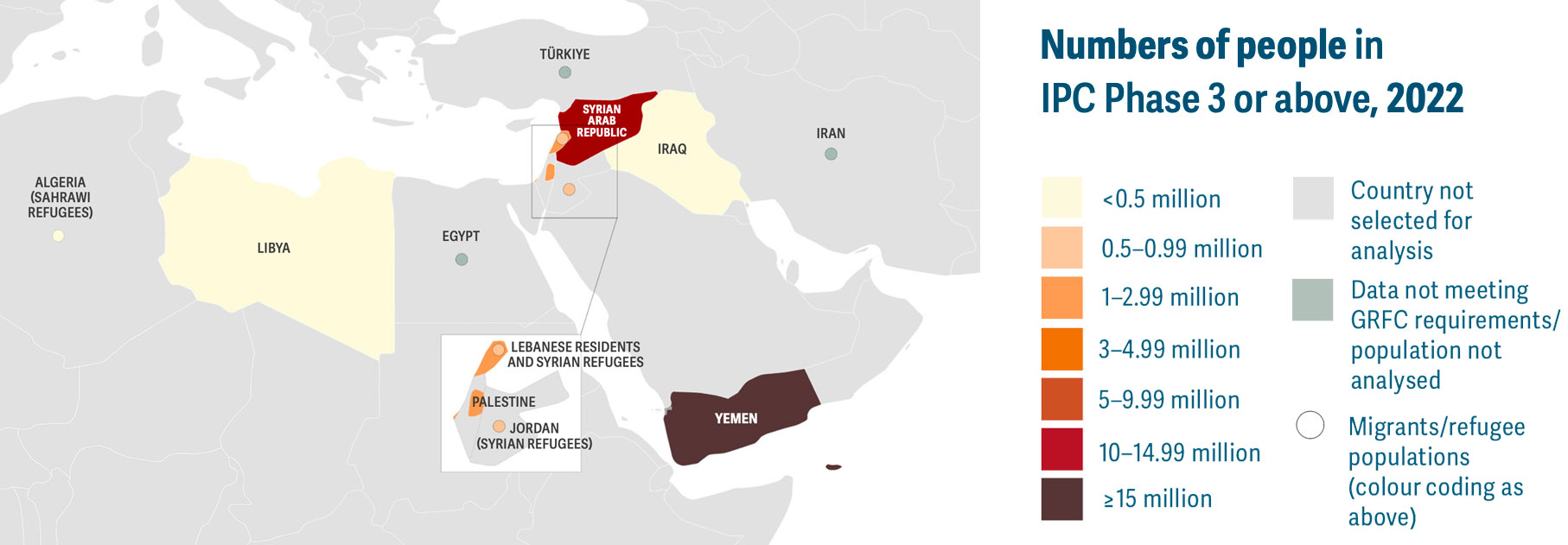

The magnitude of people facing IPC/CH Phase 3 or above is daunting, but it is that very scale that drives urgency. Earlier intervention can reduce food gaps and protect assets and livelihoods at a lower cost than late humanitarian response. Yet too often the international community waits for a Famine (IPC/CH Phase 5) classification before mobilizing additional funding. By this stage, lives and futures have already been lost, livelihoods have collapsed, and social networks disrupted with deleterious impacts on the lives of an unborn generation. Populations in IPC/CH Phase 3 are already unable to meet their minimum food needs and are compelled to protect food consumption by engaging in harmful coping strategies It is at this stage that action is needed to ensure immediate wellbeing, to support households’ ability to sustain themselves, and to protect families from making choices that are likely to lead to worse outcomes.
Despite having been identified by the international community as having populations of concern through UN coordinated appeals or response plans in 2022, and therefore likely to have populations facing high acute food insecurity, some countries have not been included in the GRFC 2023. This is either because data were not available or they did not meet the requirements of the GRFC for inclusion.
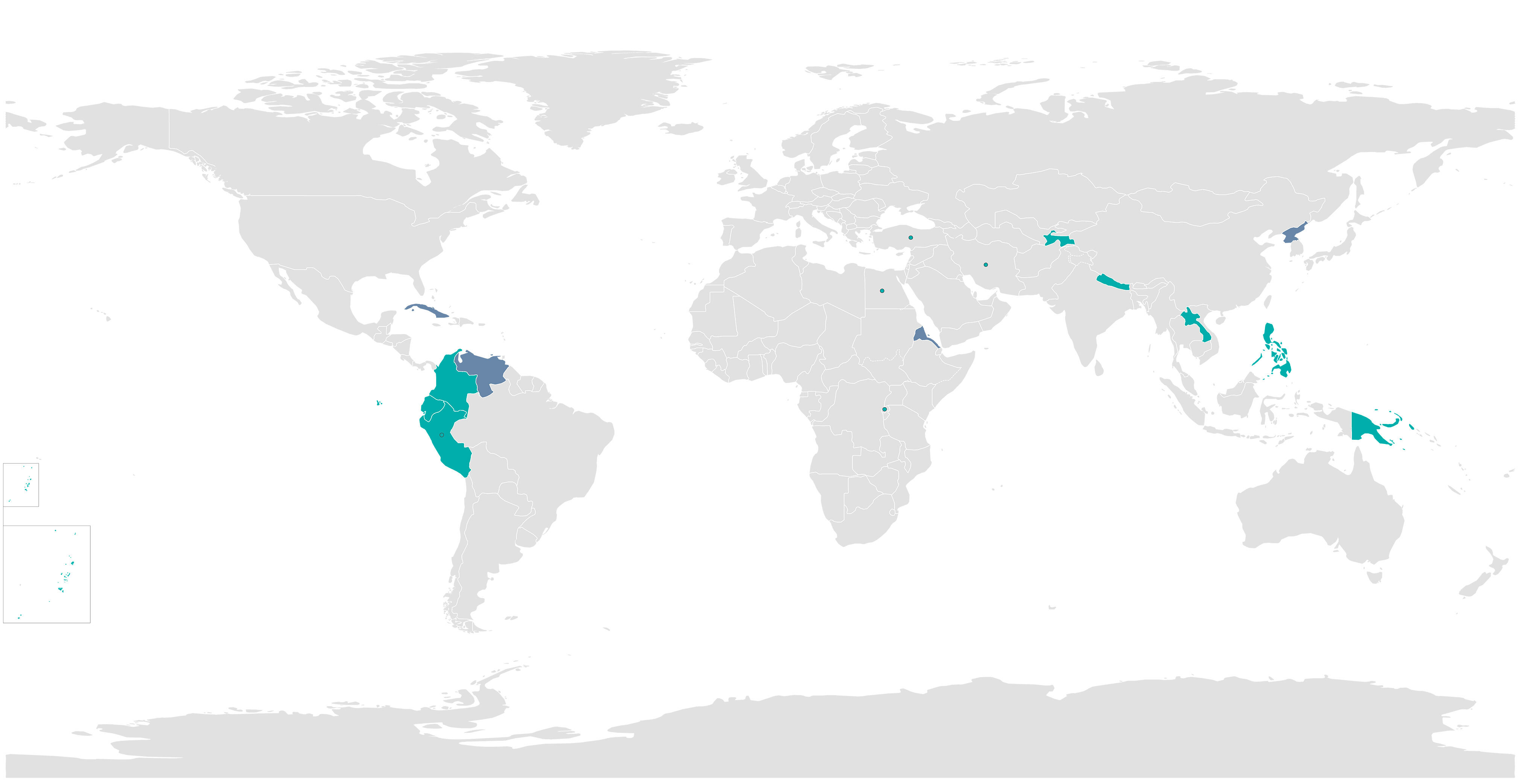
CONFLICT / INSECURITY
Conflict will continue to drive displacement and lead millions of people to face high levels of acute food insecurity in many countries including the Central African Republic, the Democratic Republic of Congo, Myanmar, Somalia, South Sudan, and Ukraine as well as the Central Sahel and Lake Chad Basin areas. Even in areas where active fighting has abated – Afghanistan, Ethiopia, the Syrian Arab Republic and Yemen – the impacts of conflict will persist throughout 2023. In the Sudan, the onset of clashes between the Sudanese Armed Forces and paramilitary forces in mid-April is extremely concerning and likely to trigger a deterioration in acute food insecurity, notably as it prompted a suspension of humanitarian assistance in the country.
ECONOMIC SHOCKS
Economic shocks are likely to drive acute food insecurity across the globe, as countries’ economic resilience has been severely undermined by a slow recovery from the COVID-19 pandemic. Persisting high food prices coupled with unsustainable debt levels in a number of food-crisis countries amid high interest rates and currency depreciation, are expected to continue to erode households’ food access and constrain the fiscal capacity of governments to deliver assistance to populations. As of March 2023, food prices were at exceptionally high levels in Ethiopia, Ghana, Malawi, Myanmar, Namibia, Pakistan, Somalia, South Sudan and Zimbabwe.
WEATHER EXTREMES
The impact of the February 2023 tropical cyclone Freddy in Madagascar, Malawi and Mozambique will sustain acute food insecurity conditions throughout 2023. In Ethiopia, Kenya and Somalia, recovery from the three-year drought across the Horn of Africa, will be prolonged and a Risk of Famine in two districts of Somalia has again been raised. Forecast to return in June 2023, the El Niño phenomenon is likely to result in dry weather conditions in key cropping areas of Central America, Southern Africa and Far East Asia, while excessive rainfall and possible flooding is foreseen in Near East Asia and East Africa.
NATURAL DISASTERS
Even before the devastating February 2023 earthquakes, the acute food security outlook for the Syrian Arab Republic was precarious. Earthquake-affected areas were home to almost 3 million IDPs and the destruction and losses of physical capital (especially in agriculture) are estimated at USD 5.2 billion. Inflation is expected to increase substantially (WB, March 2023).
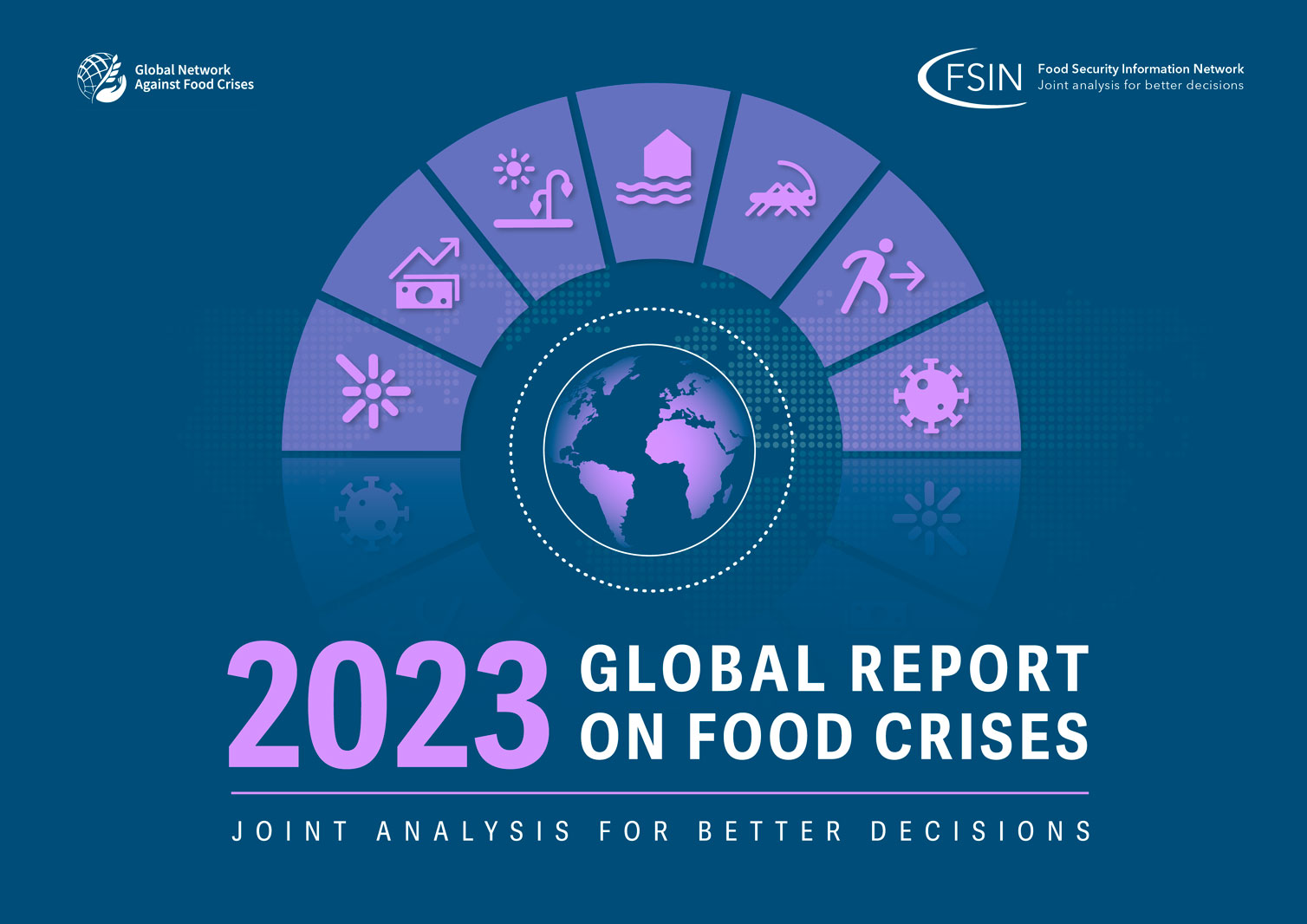
Global Report on Food Crisis 2023
DOWNLOAD